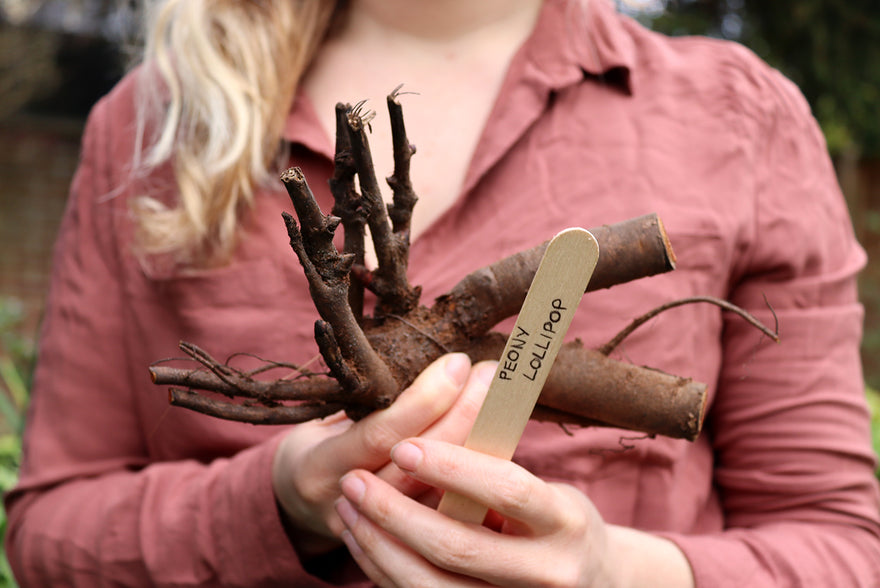
Benefits of bare root perennials
Do you want to create a garden which is beautiful, low maintenance and long lasting? Planting a good selection of hardy and undemanding perennials is a great place to start. Perfection takes time with plants and gardens, but there’s no time like the present to get started on transforming your garden into a mini oasis which you can be proud of and, above all, enjoy as it matures and improves for years to come.
Instant impact, ready-grown flowering plants may seem appealing, but they can be expensive and often their performance is short-lived. In terms of longevity, establishing hardy perennials from bare roots is a more cost effective and also rewarding way to achieve those much-desired garden goals.
There are plenty of benefits to choosing bare root perennials, which is perhaps why they are so rapidly increasing in popularity. Bare root perennials are an economical, reliable and more environmentally friendly choice. Read on to discover more about bare roots and all the benefits you can look forward to by growing them...
What are bare root perennials?
When a plant is supplied as a bare root, what you receive is the root system of a plant which is in a dormant state. While dormant, the root system doesn’t require much in the way of moisture or light to keep it fresh and healthy before it’s replanted. The root system will be joined at the top by the crown of the plant – the area from where the shoots emerge. Some roots, such as peonies, are chunkier and look more stick-like with visible buds on the sides.

When perennials establish, they tend to form larger clumps which can be lifted when dormant, split into multiple pieces and then replanted so that they grow into new established clumps. Bare root plants are treated in a similar way, by simply lifting (harvesting) them when they are dormant, then transporting them in time to be replanted before they wake up again in spring. The plant is subjected to minimal disturbance during this process while it is in a state of dormancy, before the new season’s root growth starts to take place.
Dividing and lifting perennials is something which has been done by gardeners for centuries to split and multiply plants. There’s no need to change a system which works perfectly well—this old and trusted method is particularly successful because it relieves the congested clump and also leaves you with larger number of healthy plants, so it’s a win-win.
Bare roots are fresh and healthy when supplied
Bare roots are lifted while the plant is dormant and then carefully packaged so that they remain fresh until it’s time to plant them. Freshly harvested plants which have been lifted, transported and replanted while dormant can start the growing season in their new location with all the enthusiasm and vigour that it had in the year before.
If you’ve ordered potted plants online before, you’ll know that sometimes they can take a turn for the worse in transit. There’s nothing more disappointing than seeing a damaged plant on arrival, but fortunately this doesn’t happen with bare root perennials. Because they aren’t in pots of soil, don’t have fragile top growth and can be packed tightly and securely, it doesn’t matter which way up the box is delivered, the roots will be carefully packaged and safe inside your parcel so there are no nasty surprises when you open it.
Plants produce healthy, vigorous growth
Compared with seed or cutting-raised plants, bare roots are already fairly mature and naturally have more vigour and growing potential in the first season than plant which is starting life from scratch. This means that in the first year, you can expect a bigger, stronger plant than you would if you sowed seeds or planted cuttings of the same variety.

Healthy growth also depends on the plant being allowed to settle in quietly. This is another bonus to planting dormant bare roots—once they have been potted or planted, they can simply concentrate on growing in tune with the season and without any setbacks. It’s best to get all transplanting done before plants start to grow because disturbance can be really damaging to a new plant—this term is usually referring to root disturbance. In spring, the plant will start to produce new root growth which is very fragile and also crucial for the plant’s survival. The worst kind of damage is the kind that you can’t really see without a microscope, affecting the tiny hair-like fibres which cover each new root and give it a much larger surface area for absorbing water and nutrients. If you remove a growing plant from soil, the soil will take many of those tiny root hairs with it, meaning the plant is greatly set back or may even die.
Bare roots are better value
Due to the fact that harvesting, preparing, storing and shipping bare root plants is less laborious, risky and requires far less space and artificial resource, you can usually pick up bare root plants at a better price than those which are supplied ready-grown in pots. Considering it doesn’t take a lot of time or work to pot up bare root plants yourself at home, it’s usually a saving worth having.
Another factor which makes bare root perennials a great value way to fill your garden is that hardy perennials will grow back every year, usually bigger and better than the previous year. They do take time to fill out, but they are certainly an excellent investment for your garden for the long term.
Bare root plants are easy to grow
Planting bare root perennials is really quite simple—anyone can do it! We recommend potting them up first in temporary pots, allowing them to grow a root ball in the pot and also some top growth. In a pot of its own, there’s soft compost, no competition from other plants and birds are less likely to peck at them. Hardy perennials can be potted up and grown on outdoors for 2-3 months, then planted into borders once they have established some initial growth. If you allow the plant to grow in the pot until it has enough roots to hold the soil together in a root ball, it easily slides out of the pot in one piece without the soil falling from the roots and damaging them.
Read more: How to grow bare root perennials
This method gives plants a gentle start, but it’s not essential and you can plant the bare roots directly into borders if you have good soil and if you mark them with a cane. Once planted, they’ll need sunlight and water, and it is necessary during their early stages of development to check on them regularly to make sure they look happy and healthy and that they are not becoming crowded by other plants or weeds.
Choose from a wide range of bare root varieties
Most herbaceous perennials can be supplied in bare root form, which means that you won’t have to be limited in your choices. Inspired by trends we see in famous and domestic gardens around us, also considering plants which will thrive in different kinds of soil, climates and spaces, we source a wide range of popular perennial varieties based on what we know people want to grow. Available to order during winter and spring, we have a huge range of perennials which we hope will inspire you! View our range of bare root perennials.
Bare root perennials are eco-friendly
There are so many reasons why bare root perennials are a more environmentally-friendly choice than potted plants. For a start, they are mainly cultivated outdoors in fields which reduces the need for vast glasshouses, artificial light, heating and water—outdoors they get most of what they need to thrive naturally. Another plus is that their cultivation doesn’t usually require industrial quantities of plastic pots, which are tricky to recycle.
Nobody likes to see plants go to waste, and the good news is that there is very little waste involved with bare root perennials because they can be harvested when needed. Those which aren’t required simply spend another year in the field.

Once harvested, bare root perennials are compact, use less space in storage and also pack securely into smaller parcels than potted plants. You can fit many more bare root plants into a box than you can with potted plants—the smaller the parcels, the fewer delivery trucks we have on our roads which also lessens the carbon footprint.
Once planted and thriving in your garden, bare root perennials continue to improve the quality of our environment by providing pollinators with essential nectar. And, of course, as with all plants they absorb carbon dioxide in our atmosphere and convert it into oxygen by the natural process of photosynthesis.
Perennial tips:
When you are planting a new area with perennials, they will return each year and gradually fill out. But it can be a few years before they really start to provide a wow-factor. In the meantime, we recommend including some first-year flowering plants with your perennials, such as dahlias, begonias, callas and lilies. These will flower and make some impact in the first year while the new perennials are settling in.
Hardy perennials can be planted directly outside into borders, but we strongly recommend that they are marked with a cane after planting so that they’re easily monitored while they’re still small. While perennials are low maintenance once established, they do require some extra care when first planted.

Over the years, your perennials will start to spread into healthy clumps. Once they reach this point, you can think about dividing them in autumn. This process involves lifting the clump, splitting it in half or quarters with a spade, then replanting each clump straight away afterwards. The divided clumps can then be spread out into a wider group, or into different areas of the garden
Popular bare root perennials to try
Cottage garden perennials
Almost anything goes in a cottage garden—the charm of this style is that it is so relaxed in terms of colour (all colours welcome), form and habit. It’s a rustic jumble of plants that all seem to blend together into a rich floral tapestry. Plants like Achillea 'Summer Pastels', Geranium 'Breeders Mix' and Gypsophila 'Bristol Fairy' are all about the flower power and this melange of colour and flower shapes will work a treat.
Gravel/dry garden perennials
Sun-loving, drought tolerant plants like Verbena bonariensis, ornamental grasses, Eryngium and Gaura look fantastic in a gravel area. They enjoy the free-draining soil and cope well with summer heat. This is a great planting option for a low maintenance garden, or if you hope to save water during the summer months. Over the years they will spread and gradually naturalise.

Prairie-style perennials
This is a relaxed style of planting which mainly involves perennials in a full spectrum of colours. It works particularly well plants which flower in warm colours among informal grasses, like Panicum and Pennisetum. Helenium, Rudbeckia, Salvia and Echinacea are often used in prairie style planting schemes.
Perennials for modern gardens
If you have a formal, modern design you may prefer to stick to a simple colour scheme with green, white and only one or two other colours. Foliage plants like hostas (for shade) and ornamental grasses (for sun) will look stylish, and you could introduce some colour with flowering perennials which have a tidy habit like Veronica, Astrantia, Siberian Iris or Echinacea.
































































































































































































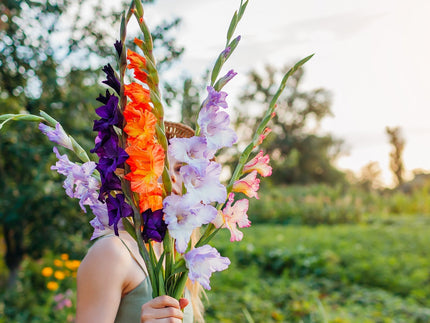
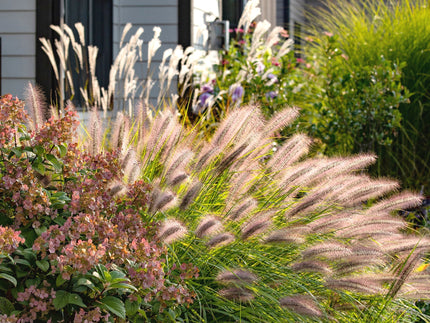
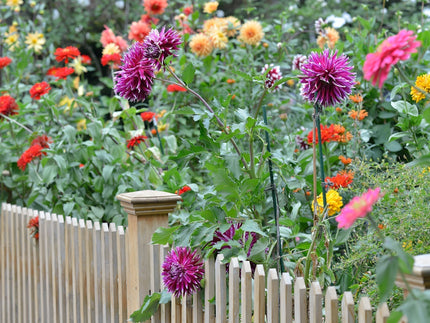
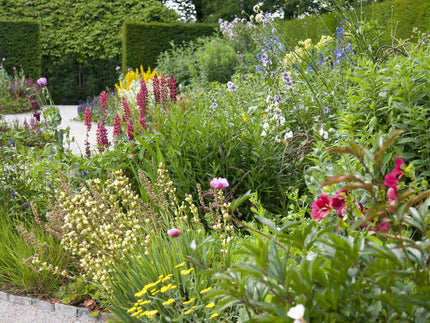
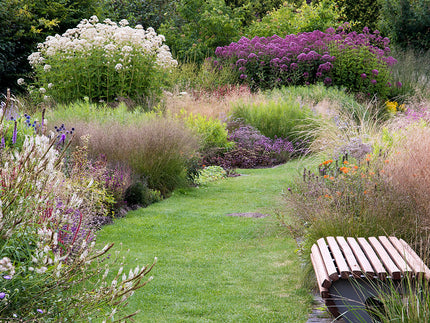
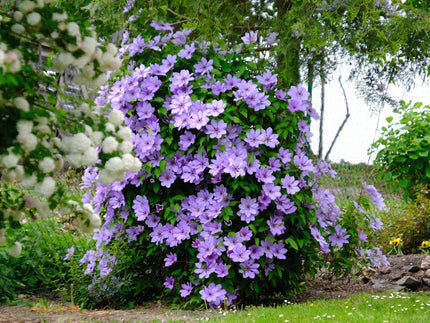


4 comments
Thank you so much for giving me this information. It helps
So much with planting up my bare root plants ordered from you.
Interesting , we have a large garden so these plants may fit in our plans
W E Roberts
Very useful. Thank you
Loved this video young lady doing the piece to camera was brilliant . She should be on Gardeners World.